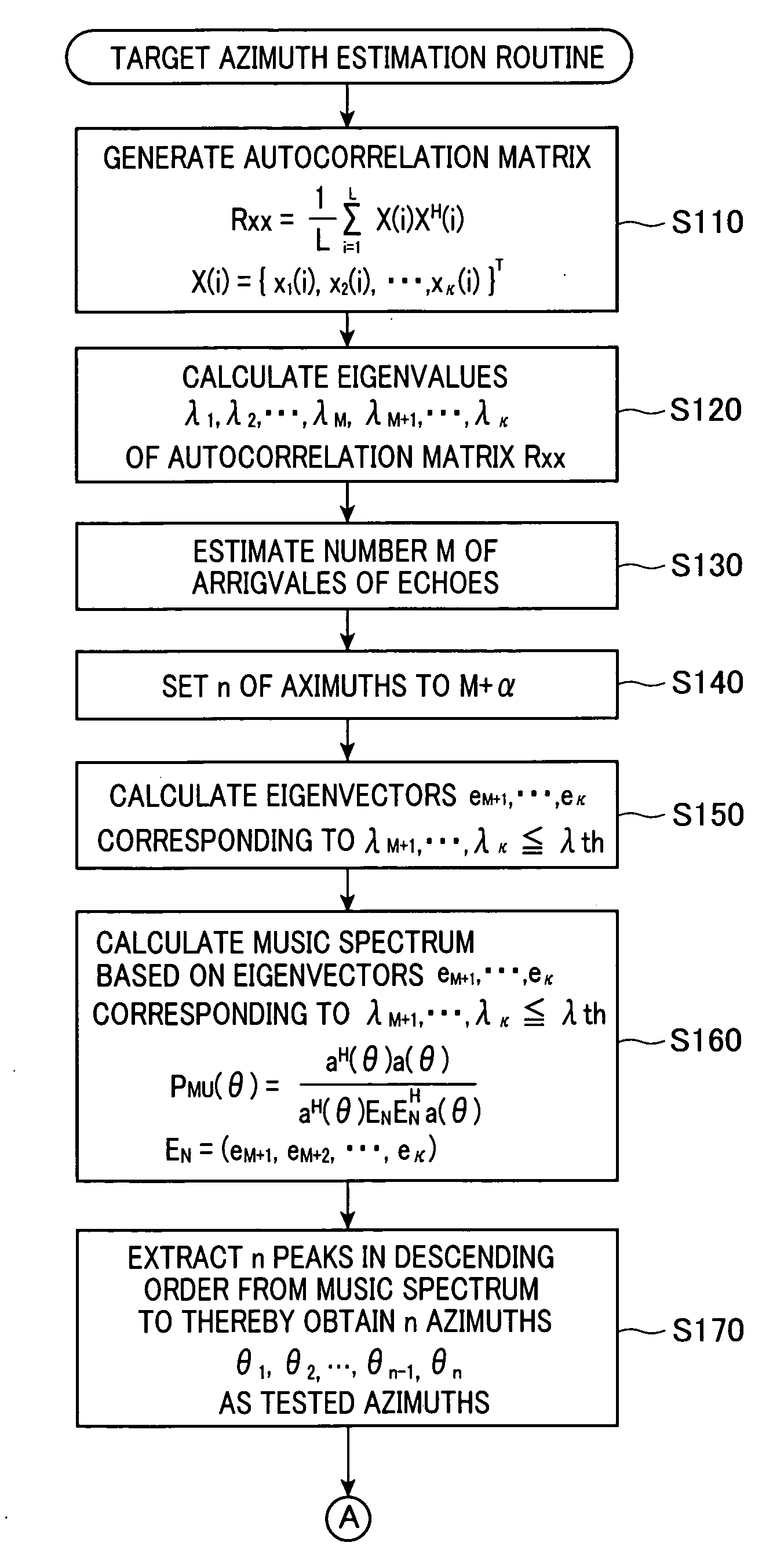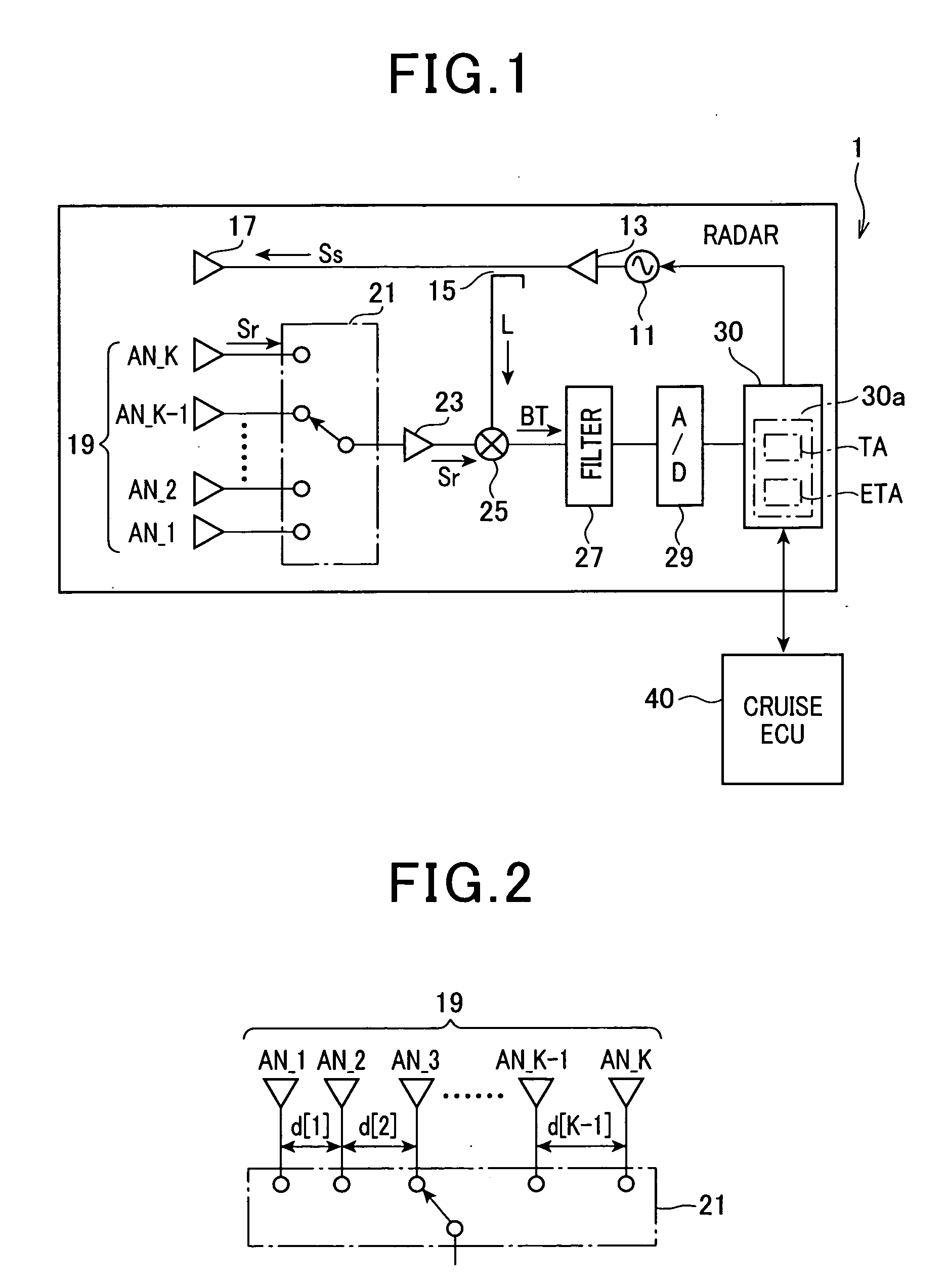Radar with non-uniformly spaced antenna array
a technology of uniform spacing and antenna array, applied in the field of radars, can solve the problems of increasing the number of antennas, increasing the cost difficulty in narrowing the space between adjacent antennas of uniform spacing antenna array, so as to reduce the effect of undesired peas, reducing the possibility of erroneous estimation, and deteriorating the estimation accuracy of azimuth
- Summary
- Abstract
- Description
- Claims
- Application Information
AI Technical Summary
Benefits of technology
Problems solved by technology
Method used
Image
Examples
first embodiment
[0084]Referring to FIG. 1, there is illustrated a radar 1 according to the first embodiment of the present invention. In the first embodiment, the radar 1 is installed in a motor vehicle and mounted on, for example, the front end of the motor vehicle.
[0085]The radar 1 is designed as an FMCW (Frequency-Modulated Continuous-Wave) radar. Specifically, the radar 1 is provided with an oscillator 11, an amplifier 13, a distributor 15, a transmitting antenna 17, and a receiving antenna array 19.
[0086]The oscillator 11 works to generate, based on a triangular modulation voltage signal, a millimeter high-frequency signal; the frequency of the millimeter high-frequency signal is linearly changed, within a preset frequency range ΔF, in a positive sense (up chirp) and a negative sense (down chirp) over time with a preset modulation cycle Cm.
[0087]The amplifier 13 works to amplify the millimeter high-frequency signal generated by the oscillator 11.
[0088]The distributor 15 works to distribute the...
second embodiment
[0210]A radar according to the second embodiment of the present invention will be described hereinafter with reference to FIGS. 10A, 10B, and 11.
[0211]The structure of the radar according to the second embodiment is substantially identical to that of the radar 1 according to the first embodiment except for the following different points. So, like parts between the radars according to the first and second embodiments, to which like reference characters are assigned, are omitted or simplified in description.
[0212]The radar 1 according to the first embodiment is designed to eliminate azimuths corresponding to undesired peaks that appear in the MUSIC spectrum based on the threshold correction table TA in which the appropriate values TD[1], . . . , TD[Q] of the threshold power level Pth corresponding to the evaluation levels RM+i are stored.
[0213]Note that there are constant patterns in principle between azimuths in which undesired peaks appear and azimuths in which peaks except for the ...
third embodiment
[0243]A radar according to the third embodiment of the present invention will be described hereinafter with reference to FIGS. 12A, 12B, and 13.
[0244]The structure of the radar according to the third embodiment is substantially identical to that of the radar according to the first or second embodiment except for the following different points. So, like parts between the radars according to the first or second embodiment and the third embodiment, to which like reference characters are assigned, are omitted or simplified in description.
[0245]The radar according to the third embodiment includes an evaluation-level table ETA stored in the memory unit 30a of the signal processor 30. The evaluation-level table ETA is illustrated in FIG. 1 by phantom line (chain double dashed line) so that the evaluation-level table ETA can be omitted in the radar 1 according to the first embodiment.
[0246]The signal processor 30 according to the third embodiment is programmed to carry out a correlation det...
PUM
 Login to View More
Login to View More Abstract
Description
Claims
Application Information
 Login to View More
Login to View More - R&D
- Intellectual Property
- Life Sciences
- Materials
- Tech Scout
- Unparalleled Data Quality
- Higher Quality Content
- 60% Fewer Hallucinations
Browse by: Latest US Patents, China's latest patents, Technical Efficacy Thesaurus, Application Domain, Technology Topic, Popular Technical Reports.
© 2025 PatSnap. All rights reserved.Legal|Privacy policy|Modern Slavery Act Transparency Statement|Sitemap|About US| Contact US: help@patsnap.com



